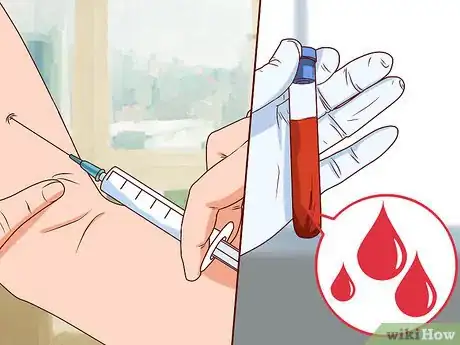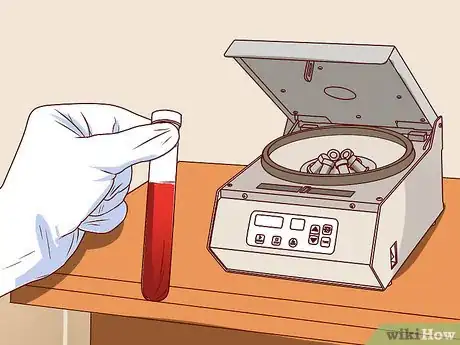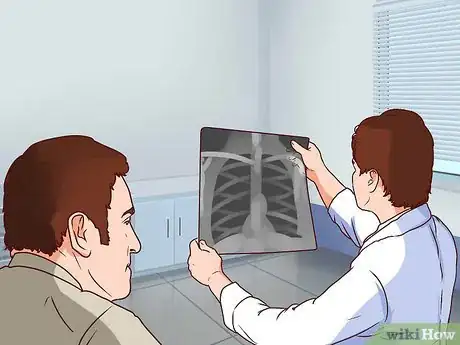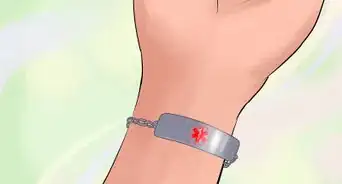This article was medically reviewed by Janice Litza, MD. Dr. Litza is a board certified Family Medicine Physician in Wisconsin. She is a practicing Physician and taught as a Clinical Professor for 13 years, after receiving her MD from the University of Wisconsin-Madison School of Medicine and Public Health in 1998.
There are 16 references cited in this article, which can be found at the bottom of the page.
wikiHow marks an article as reader-approved once it receives enough positive feedback. In this case, 97% of readers who voted found the article helpful, earning it our reader-approved status.
This article has been viewed 163,007 times.
Studies show that lupus, an autoimmune disease, is most common in women from the ages of 15 to 44.[1] It primarily affects the organs, such as the brain, skin, kidneys, and joints. Its symptoms often masquerade as signs of other illnesses, so the condition can be difficult to diagnose. Experts note that understanding the symptoms and diagnosis procedures for lupus can help you catch and treat this disease, as well as avoid potential triggers.[2]
Steps
Recognizing Lupus Symptoms
-
1Check your face for a butterfly rash. An average of 30 percent of lupus patients develop a characteristic rash over the face often said to look like a butterfly or wolf bite. The rash spans across the cheeks and nose, often flaring out over the entirety of the cheeks and occasionally covering a portion of skin near the eyes.
- Also check for discoid rashes around your face, scalp, and neck. These rashes show up as red, raised patches, and they can be so severe that they leave scars even after they’re gone.
- Pay special attention to rashes triggered or worsened by sunlight. Sensitivity to ultraviolet light, whether natural or artificial, can trigger sores on sun-exposed parts of the body and may worsen a butterfly rash on your face. This rash is more severe and develops faster than a usual sunburn would.
-
2Note any mouth or nasal sores. If you frequently get sores on the roof of your mouth, along the side of your mouth, on your gums, or inside your nose, this could be another warning sign. In particular, this is often the case if these sores are not actually "sore." In most cases, mouth and nasal sores associated with lupus are pain-free.
- If these sores get worse in sunlight, this is an even stronger sign of lupus. This is called photosensitivity.
Advertisement -
3Look for symptoms of inflammation. Inflammation of the joints, lungs, and the lining around the heart commonly occurs in patients who have lupus. On top of this, blood vessels are usually inflamed.[3] Most notably, you might see inflammation and swelling around the feet, legs, hands, and eyes.[4]
- If you have inflamed joints, they may feel warm and tender and look swollen and red.
- Inflammation of the heart and lungs can be detected at home based on chest pain. If you feel a sharp chest pain when you cough or take a deep breath, you can count this as a possible symptom. The same applies if you feel shortness of breath during these periods.
- Other signs that your heart or lungs could be inflamed include abnormal heart rhythms and the coughing up of blood.[5]
- Inflammation can also take place in the digestive tract and can be spotted through symptoms like abdominal pain, nausea, and vomiting.
-
4Pay attention to your urine. While urine abnormalities can be hard to detect at home, there are a few symptoms you might be able to detect. If a kidney is unable to filter your urine due to lupus, your feet might swell. Worse yet, if your kidneys have begun failing, you might feel nausea or weakness.
-
5Note any problems with your brain and nervous system. Lupus can affect the nervous system. Some symptoms, like anxiety, headaches, and vision problems, are common and difficult to assign to lupus; however, seizures and changes in personality are concrete symptoms taken very seriously. [6]
- Note that while headaches are very common with lupus, they can be very difficult to attribute to the disease. Headaches are common and have many possible causes.
-
6Ask yourself if you are more fatigued than usual. Extreme fatigue is another common symptom of lupus. It can be caused by a number of different factors, but often these factors can be linked to lupus. When fatigue is accompanied by fever, you may be even more certain that it is lupus.[7]
-
7Watch for other strange things in your body. You may notice that your fingers or toes change color (white or blue) when exposed to cold. This is called Raynaud’s phenomenon, and is common with lupus. You may also notice dry eyes and shortness of breath. If all of these symptoms occur together, you may be dealing with lupus.[8]
Diagnosing Lupus
-
1Prepare for your appointment with the doctor. You can go to any general physician for a lupus diagnosis, but that doctor may refer you to a rheumatologist who may order more confirmatory tests and help manage symptoms with specific medication for lupus. Typically, though, the start of a professional medical diagnosis will be at a standard physician's office.[9]
- Before your appointment, write down information about when your symptoms began and how frequent they are. Also make a note of any medications and supplements you take as possible triggers.[10]
- If a parent or sibling has ever had lupus or another autoimmune disorder, you should bring that information with you as well. Patient and family history are very important for diagnosing lupus.
-
2Prepare for an antinuclear antibody (ANA) test. ANA is an antibody that attacks proteins in the body, and these ANA are present in most people with an active form of lupus. This is often used as an initial screening test; however, not everyone with a positive ANA test has lupus. Further tests are needed to confirm the presence of lupus.[11]
- For example, a positive ANA test can also indicate scleroderma, Sjogren’s syndrome, and other autoimmune diseases.
-
3Get a complete blood count. This blood test measures the amount of red blood cells, white blood cells, platelets, and hemoglobin in your blood. Certain abnormalities can be another possible sign of lupus. For example, this test can reveal anemia, which is a common symptom of lupus.[12]
- Note that this test does not diagnose lupus by itself. Many other conditions can also cause similar abnormalities.
-
4Expect blood tests for inflammation. Your doctor may do several tests that confirm an inflammatory condition, though they will not definitively prove you have lupus. One such test measures your erythrocyte sedimentation rate (ESR). This test measures how fast it takes red blood cells to settle at the bottom of a test tube in one hour. A fast rate can indicate lupus. A fast rate can also be symptomatic of other inflammatory conditions, cancers, and infections, so it is not an absolute test, either.[13]
- Another test that is non-specific for lupus but can test for inflammation is a C-reactive protein (CRP) test. This liver protein can indicate the presence of inflammation, but there are many other conditions that can cause this protein to show up.
-
5Find out about other blood tests. Since no blood test is exclusive to lupus, doctors usually perform a range of blood tests to narrow down the diagnosis. Symptoms usually must match at least four out of the main eleven symptoms that doctors look for. Other possible tests your doctor might use include: [14]
- A blood test measuring your erythrocyte sedimentation rate. This test measures how fast it takes red blood cells to settle at the bottom of a test tube in one hour. A fast rate can indicate lupus. A fast rate can also be symptomatic of other inflammatory conditions, cancers, and infections, so it is not an absolute test, either.[15]
- An antibodies to phospholipids (APL ) test. An APL test looks for antibodies that attack phospholipids, and they tend to be present in 30 percent of patients with lupus.
- An antibodies to Sm test. This antibody attacks the Sm protein in the cell nucleus, and it is present in about 30 to 40 percent of lupus patients. Moreover, it rarely shows up in people without lupus, so a positive result almost always guarantees a lupus diagnosis.
- An anti-dsDNA test. Anti-dsDNA is a protein that attacks double-stranded DNA. Roughly 50 percent of lupus patients have this protein in their blood. It is very rare in people without lupus, so a positive result almost always results in a lupus diagnosis.
- Anti-Ro (SS-A) and Anti-La (SS-B) tests. These antibodies attack the RNA proteins in your blood. It is more common in patients with Sjögren's syndrome, however.
-
6Get a urine test. Urine tests monitor the kidneys, and damaged kidneys can be a sign of lupus. You might be required to provide a urine sample so that the doctor can do a urinalysis. This test looks at your urine for extra proteins or the presence of red blood cells.[16]
-
7Ask about imaging tests. Your doctor might order an imaging test if they think that you have a form of lupus that affects your lungs or heart. A traditional chest x-ray might be ordered to look at your lungs. An echocardiogram will look at your heart.[17]
- A chest x-ray can reveal shadows in your lungs, which could indicate areas of fluid or inflammation.
- An echocardiogram uses sound waves to measure the beating of your heart and to detect possible problems in the heart.
-
8Inquire about a biopsy. If your doctor suspects that lupus has damaged your kidneys, they may do a kidney biopsy. The goal of this biopsy is to obtain a sample of kidney tissue. They will assess the condition of your kidneys based on how much damage has occurred, and what kind of damage it is. Doctors can use this biopsy to determine the best treatment for lupus.[18]
Learning About Lupus
-
1Learn what lupus is. Lupus is an autoimmune disease, which means that it causes the immune system to attack healthy parts of your body. Again, it mostly affects the organs, such as the brain, skin, kidneys, and joints.[19] The disease is also chronic, which means it lasts for the long-term. It causes the body to become inflamed as the immune system attacks healthy tissue. [20]
- There is no cure for lupus; however, treatments can ease the symptoms.
-
2Understand the three primary types of lupus. When people refer to lupus, they usually refer to systemic lupus erythematosus (SLE). This type of lupus affects your skin and your organs, especially your kidneys, lungs, and heart. There are other types of lupus, including cutaneous lupus erythematosus and drug-induced lupus.
- Cutaneous lupus erythematosus only affects the skin and does not threaten the other organs of your body. It rarely develops into SLE.
- Drug-induced lupus can affect the skin and your interior organs, but it is induced by the use of specific medications. It usually goes away once those medications are out of the patient's system. The symptoms associated with this form of lupus are typically rather mild.
-
3Identify the causes. Although it has been difficult for doctors to understand lupus, over time they have identified its characteristics. Lupus appears to be triggered by a combination of your genes and your environment. In other words, if you have a genetic predisposition for lupus, environmental factors can trigger it.[21]
- Common lupus triggers include medications, infections, or contact with sunlight.
- Lupus might be triggered by sulfa drugs, drugs that make you more sensitive to sunlight, penicillin, or antibiotics.[22]
- Physical conditions that can trigger lupus include infections, the common cold, a virus, being exhausted, getting an injury, or emotional duress.
- It is the ultraviolet rays from sun that can trigger lupus. Ultraviolet rays from fluorescent light bulbs can do the same thing.
Expert Q&A
-
QuestionIf I'm losing my hair dye to lupus, not medication, will it eventually stop? It's very noticeable.
 Chris M. Matsko, MDDr. Chris M. Matsko is a retired physician based in Pittsburgh, Pennsylvania. With over 25 years of medical research experience, Dr. Matsko was awarded the Pittsburgh Cornell University Leadership Award for Excellence. He holds a BS in Nutritional Science from Cornell University and an MD from the Temple University School of Medicine in 2007. Dr. Matsko earned a Research Writing Certification from the American Medical Writers Association (AMWA) in 2016 and a Medical Writing & Editing Certification from the University of Chicago in 2017.
Chris M. Matsko, MDDr. Chris M. Matsko is a retired physician based in Pittsburgh, Pennsylvania. With over 25 years of medical research experience, Dr. Matsko was awarded the Pittsburgh Cornell University Leadership Award for Excellence. He holds a BS in Nutritional Science from Cornell University and an MD from the Temple University School of Medicine in 2007. Dr. Matsko earned a Research Writing Certification from the American Medical Writers Association (AMWA) in 2016 and a Medical Writing & Editing Certification from the University of Chicago in 2017.
Family Medicine Physician Disease activity is very important in the progression of Lupus. If you are losing hair from scarring and a discoid rash, then it is important to see a doctor immediately. This hair loss may be permanent.
Disease activity is very important in the progression of Lupus. If you are losing hair from scarring and a discoid rash, then it is important to see a doctor immediately. This hair loss may be permanent. -
QuestionDo you have any suggestions for something to put on your face to relieve hot red cheeks?
 Luba Lee, FNP-BC, MSLuba Lee, FNP-BC is a Board-Certified Family Nurse Practitioner (FNP) and educator in Tennessee with over a decade of clinical experience. Luba has certifications in Pediatric Advanced Life Support (PALS), Emergency Medicine, Advanced Cardiac Life Support (ACLS), Team Building, and Critical Care Nursing. She received her Master of Science in Nursing (MSN) from the University of Tennessee in 2006.
Luba Lee, FNP-BC, MSLuba Lee, FNP-BC is a Board-Certified Family Nurse Practitioner (FNP) and educator in Tennessee with over a decade of clinical experience. Luba has certifications in Pediatric Advanced Life Support (PALS), Emergency Medicine, Advanced Cardiac Life Support (ACLS), Team Building, and Critical Care Nursing. She received her Master of Science in Nursing (MSN) from the University of Tennessee in 2006.
Board-Certified Family Nurse Practitioner Cool compresses over your ace can be very soothing. You can also try applying some aloe vera gel, olive oil, cod liver oil, or vitamin E oil to your face to help soothe your skin. Use any of these natural remedies on a regular basis to get rid of the problem. These oils are also good for various other skin ailments.
Cool compresses over your ace can be very soothing. You can also try applying some aloe vera gel, olive oil, cod liver oil, or vitamin E oil to your face to help soothe your skin. Use any of these natural remedies on a regular basis to get rid of the problem. These oils are also good for various other skin ailments.
Warnings
- If you suspect that you might have lupus, schedule an appointment with your doctor. Do this as soon as possible, even if you do not have a large number of symptoms. The condition can turn into something very serious within a short amount of time, so it is better to err on the side of caution.⧼thumbs_response⧽
References
- ↑ https://www.cdc.gov/lupus/basics/women.htm
- ↑ https://www.mayoclinic.org/diseases-conditions/lupus/diagnosis-treatment/drc-20365790
- ↑ https://medlineplus.gov/ency/article/000435.htm
- ↑ http://www.lupus.org/answers/entry/common-symptoms-of-lupus
- ↑ http://www.nlm.nih.gov/medlineplus/ency/article/000435.htm
- ↑ https://medlineplus.gov/ency/article/000435.htm
- ↑ http://www.mayoclinic.org/diseases-conditions/lupus/basics/symptoms/con-20019676
- ↑ http://www.mayoclinic.org/diseases-conditions/lupus/basics/symptoms/con-20019676
- ↑ http://www.lupus.org/answers/entry/what-kind-of-doctor-can-diagnose-lupus
- ↑ http://www.mayoclinic.org/diseases-conditions/lupus/basics/preparing-for-your-appointment/con-20019676
- ↑ http://www.rheumatology.org/I-Am-A/Patient-Caregiver/Diseases-Conditions/Antinuclear-Antibodies-ANA
- ↑ http://www.mayoclinic.org/diseases-conditions/lupus/basics/tests-diagnosis/con-20019676
- ↑ http://www.mayoclinic.org/diseases-conditions/lupus/basics/tests-diagnosis/con-20019676
- ↑ http://www.lupus.org/answers/entry/lupus-tests
- ↑ http://www.mayoclinic.org/diseases-conditions/lupus/basics/tests-diagnosis/con-20019676
- ↑ http://www.mayoclinic.org/diseases-conditions/lupus/basics/tests-diagnosis/con-20019676
- ↑ http://www.mayoclinic.org/diseases-conditions/lupus/basics/tests-diagnosis/con-20019676
- ↑ http://www.mayoclinic.org/diseases-conditions/lupus/basics/tests-diagnosis/con-20019676
- ↑ https://medlineplus.gov/ency/article/000435.htm
- ↑ http://www.mayoclinic.org/diseases-conditions/lupus/basics/definition/con-20019676
- ↑ http://www.mayoclinic.org/diseases-conditions/lupus/basics/causes/con-20019676
- ↑ http://www.lupus.org/answers/entry/what-are-common-triggers-for-a-lupus-flare
About This Article
To find out if you have lupus, look out for common symptoms including a butterfly rash on your face, sores on your mouth, nose, and gums, and inflammation. Other symptoms you should check for are extreme fatigue, anxiety, headaches, and vision problems. If you recognize these symptoms, make an appointment with your doctor, and prepare to take blood tests and an antinuclear antibody test. After the diagnosis, take the medication your doctor has prescribed and ask about a biopsy if you think your kidneys were damaged by lupus. To learn more from our Family Physician co-author, like other tests your doctor may perform to diagnose lupus, keep reading!























-Step-14.webp)



















































Medical Disclaimer
The content of this article is not intended to be a substitute for professional medical advice, examination, diagnosis, or treatment. You should always contact your doctor or other qualified healthcare professional before starting, changing, or stopping any kind of health treatment.
Read More...